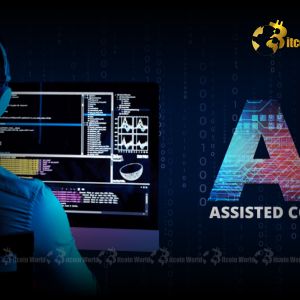AI Coding Tools: Unlocking the Terminal’s Astonishing Power for Development
6 min read
BitcoinWorld AI Coding Tools: Unlocking the Terminal’s Astonishing Power for Development For years, the landscape of AI-powered software development has been dominated by sophisticated code-editing tools like Cursor, Windsurf, and GitHub’s Copilot. These platforms became the go-to for developers looking to leverage artificial intelligence to streamline their coding processes. However, a quiet yet profound revolution is underway, one that sees AI coding tools shifting their focus to a seemingly unexpected place: the terminal. This move, driven by the increasing capabilities of agentic AI and the rise of ‘vibe-coding,’ is poised to redefine how AI systems interact with software, moving beyond mere code generation to direct system interaction. The Astonishing Shift: Why AI Coding Tools Are Embracing the Terminal When you think of a terminal, your mind might conjure images of a black-and-white screen from a 90s hacker movie. It’s an old-school interface, lacking the visual flair of modern integrated development environments (IDEs). Yet, beneath its unassuming exterior lies an extremely powerful interface, especially for those who master its commands. While code-based agents excel at writing and debugging code, the journey from written code to a functional, deployable application often requires direct interaction with the system’s shell. This is where the terminal steps in, offering a direct conduit to run programs, manipulate data, and configure environments. The clearest indicator of this shift comes from major AI research labs. Since February, industry giants like Anthropic, DeepMind, and OpenAI have launched command-line coding tools. Anthropic introduced Claude Code, DeepMind rolled out Gemini CLI, and OpenAI released CLI Codex. These tools have rapidly become some of their most popular offerings. While they might operate under familiar branding, the underlying mechanics represent a significant evolution in how AI agents engage with computers, both online and offline. This quiet revolution, often overlooked, holds immense implications for the future direction of AI-powered software development . From Code Editors to Command Lines: The Rise of Agentic AI in the Shell The growing power of agentic AI is a primary catalyst for this transition. Unlike earlier AI assistants that primarily suggested code snippets or debugged existing code, agentic AI systems are designed to operate more autonomously, taking a series of steps to achieve a goal. This step-by-step problem-solving approach aligns perfectly with the procedural nature of terminal commands. Instead of just editing code within a graphical interface, these agents are now capable of interacting directly with the shell, performing tasks that go beyond the confines of a code editor. Alex Shaw, co-creator of the leading terminal-focused benchmark TerminalBench, believes this is just the beginning. “Our big bet is that there’s a future in which 95% of LLM-computer interaction is through a terminal-like interface,” Shaw states. This perspective highlights the versatility of the terminal, which operates at a very low level in the developer stack, making it an ideal environment for running sophisticated AI agents that need to control various aspects of a system. Transforming Software Development: Benefits and Breakthroughs The timing of this shift is particularly noteworthy, as some prominent code-based tools are facing challenges. The AI code editor Windsurf, for instance, has experienced significant upheaval due to dueling acquisitions, with key executives moving to Google and the remaining entity acquired by Cognition. This has left the consumer product’s long-term viability uncertain. Furthermore, recent research suggests that developers might be overestimating the productivity gains from conventional AI coding tools. A METR study comparing Cursor Pro, Windsurf’s main competitor, found that while developers anticipated completing tasks 20-30 percent faster, their observed process was nearly 20 percent slower. This indicates that traditional code assistants were, in some cases, costing programmers valuable time. This situation has created an opening for companies like Warp, which currently leads the TerminalBench rankings. Warp positions itself as an “agentic development environment,” bridging the gap between comprehensive IDE programs and pure command-line tools like Claude Code. Zach Lloyd, Warp’s founder, remains highly optimistic about the terminal’s potential. He views it as a means to tackle problems that would be beyond the scope of a code editor like Cursor, such as configuring a Git server or troubleshooting why a script fails to run. Lloyd emphasizes, “The terminal occupies a very low level in the developer stack, so it’s the most versatile place to be running agents.” How do terminal-based tools measure success? To truly grasp the difference, consider the benchmarks used to evaluate these tools. The previous generation of developer tools , primarily code-based, focused on solving GitHub issues, which formed the basis of the SWE-Bench test. Each problem on SWE-Bench represents an open issue from GitHub – essentially, a piece of broken code that needs fixing. Models would iterate on the code until a working solution was found. While integrated products like Cursor offered more sophisticated approaches, the core methodology remained centered on transforming non-functional code into working code. Terminal-based tools, however, adopt a broader perspective. They look beyond just the code to encompass the entire environment in which a program operates. This includes not only coding tasks but also more DevOps-oriented responsibilities, such as setting up dependencies, configuring servers, or diagnosing system-level issues. For example, a TerminalBench problem might challenge an agent to reverse-engineer a compression algorithm from a given decompression program and target text file. Another scenario might require the agent to build the Linux kernel from source, even if it means first downloading the source code itself. These challenges demand the kind of persistent problem-solving ability essential for experienced programmers. “What makes TerminalBench hard is not just the questions that we’re giving the agents,” says Shaw, “it’s the environments that we’re placing them in.” This crucial aspect means tackling problems step-by-step, a skill that underpins the power of agentic AI. However, even the most advanced agentic models currently struggle to handle all these complex environments. Warp, despite its leading score on TerminalBench, solved just over half of the problems, highlighting both the benchmark’s difficulty and the significant potential yet to be unlocked in terminal-based AI. Navigating the Future of Developer Tools: Challenges and Opportunities Despite the existing challenges, the value proposition of terminal-based AI coding tools is becoming increasingly difficult to ignore. Lloyd believes that these tools are already capable of reliably handling much of a developer’s non-coding workload. “If you think of the daily work of setting up a new project, figuring out the dependencies and getting it runnable, Warp can pretty much do that autonomously,” Lloyd explains. “And if it can’t do it, it will tell you why.” This capability frees up developers to focus on more complex, creative coding tasks, potentially leading to significant productivity gains that traditional code assistants have struggled to deliver. The implications for the future of software development are profound. As agentic AI continues to evolve, its ability to interact seamlessly with the terminal will likely lead to more autonomous development environments. This could mean less time spent on tedious setup and debugging, and more time on innovation. Developers may find themselves becoming more like orchestrators, guiding AI agents through complex tasks rather than manually executing every step. This shift promises a more efficient and perhaps even more intuitive development experience, pushing the boundaries of what AI can achieve in the coding world. The quiet pivot of AI coding tools towards the terminal represents a monumental shift in the landscape of software development. Fueled by the advancements in agentic AI and the limitations of traditional code editors, this move unlocks a new level of versatility and efficiency. While challenges remain in fully harnessing the terminal’s potential, the pioneering work by major labs and companies like Warp suggests a future where AI interacts directly with the system’s core, transforming how we build, deploy, and maintain software. This subtle yet powerful evolution promises a more autonomous and productive future for developers worldwide. To learn more about the latest AI market trends, explore our article on key developments shaping AI features. This post AI Coding Tools: Unlocking the Terminal’s Astonishing Power for Development first appeared on BitcoinWorld and is written by Editorial Team

Source: Bitcoin World



